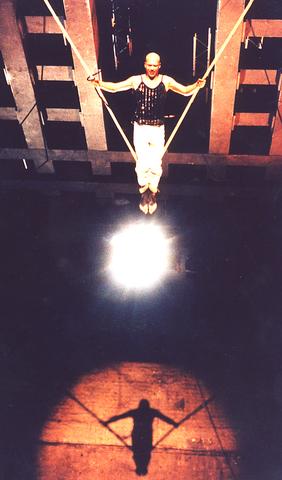In Cirkus Cirkor, you will find juggling, trapeze and the tight rope, but you will not see lion tamers, clown cars and strong men. Like other contemporary arts -- and the Cirkus Cirkor troupe most definitely views circus as an art form -- circus is shedding tradition and smashing the old genres. Now, stilt walking involves cybernetic appendages and modern dance, and juggling is a narrative with a soundtrack.
"The dream we had was to create a new kind of performance using high wire, trapeze, acrobatics and other circus acts, and to incorporate theater, dance, music and other arts," said Tilde Bjofors, who founded the troupe in Sweden in 1995 and serves as the group's director.

This weekend, she brings Cirkus Cirkor to Taipei's Sun Yat Sen Memorial Hall for three performances of Trix, the group's latest show.

PHOTO COURTESY OF TAIPEI ARTS INTERNATIONAL ASSOCIATION
Cirkus Cirkor is a contemporary circus, a scion form of traditional circus that was pioneered in France around 30 years ago and is best known for that country's Cirque du Soleil.
Unlike traditional circus, contemporary circus does not rely solely on stunts and showmanship and is not conceived as a simple succession of acts. Shows like Trix are uniquely formed with specific themes, moods and even stories. The six major shows and two minor shows Cirkus Cirkor has created so far have involved collaborations with dance choreographers, musicians, costume designers and theater and film directors.

PHOTO COURTESY OF TAIPEI ARTS INTERNATIONAL ASSOCIATION
"Every show has been a new way of finding meetings with other art forms," said Bjofors, who created Trix in with Orionteatern, Stockholm's top experimental theater. "This performance is a way for the circus to come into the theater."
Each segment of Trix is self-contained and centered around a single circus act, yet each also unfolds its own surreal narrative. One scene consists of a woman inside a giant translucent balloon who walks, bounces and rolls through a dance with two men who vie for her attention. And even though the device is simple -- the balloon as a symbol of isolation and separation -- the play among elements is engaging, especially when the players explore the limits of the latex wall by sticking arms legs and heads through the balloon's single orifice.
In another scene, the juggler is chased around the stage by three women, whose costumes allow them to grow mid-scene into giants between three and four meters tall. The juggler, who seems a Lilliputian among the giant women, runs between them, waving and curling his balls in and around his body as well as through the air. The movements are lyrical and strange, and the segment's overall visual effects recall Alice in Wonderland or Pink Floyd's The Wall much more than any popcorn and cotton candy show.
Remaining acts feature mime, a magician, a dance routine on a tight wire 5mm in width, contortionists, pole acrobatics (inspired in part by traditional Chinese acrobatics), clowns, the trapeze, and a man who drops from 7m on two bungy cords and then proceeds to catapult himself around the stage like a human slingshot.
Visual impressions and multi-disciplinary performances are the focus of this year's Taipei International Arts Festival, a two month affair which brings Cirkus Cirkor as part of a series of seven performance groups that will play in several of Taipei's major theaters. "We're trying to show audiences something that will really make their eyes pop out," said Serina Chen, the festival's director.
Though Cirkus Cirkor certainly has eye-popping effects, it also has a strong focus on music. Providing accompaniment to every act is Urga, a seven-piece band situated at the back of the stage. Playing everything from punk to reggae, the band has worked with Cirkus Cirkor since the group's inception. Independently, Urga has also found success in Sweden playing rock festivals and releasing CDs, the latest of which is titled Urgasm.
In Trix, Urga's music completes the effect of each performance segment, making every routine an autonomous and nearly hypnotic experience. In a way, the complement of sound makes for a presentation that is almost cinematic, with music, performance and effects all combining to produce mood and narrative. But remember, it is still a circus. It may be true that there is no more big top, but for the Cirkus Cirkor, the show most definitely goes on.
Performance Notes
What: Trix, a performance by Cirkus Cirkor and Orionteatern
When: Tonight, 7:30pm; tomorrow, 7:30; and Sunday, 2:30pm
Where: Sun Yat Sen Memorial Hall (台北國立國父紀念館) Taipei, 505 Jenai Rd., Sec. 4 (台北市仁愛路4段505號)
Tickets: NT$400 to NT$1,800, available at ERA ticket outlets. For ticket information call (02)2341-9898.

In the next few months tough decisions will need to be made by the Taiwan People’s Party (TPP) and their pan-blue allies in the Chinese Nationalist Party (KMT). It will reveal just how real their alliance is with actual power at stake. Party founder Ko Wen-je (柯文哲) faced these tough questions, which we explored in part one of this series, “Ko Wen-je, the KMT’s prickly ally,” (Aug. 16, page 12). Ko was open to cooperation, but on his terms. He openly fretted about being “swallowed up” by the KMT, and was keenly aware of the experience of the People’s First Party

Aug. 25 to Aug. 31 Although Mr. Lin (林) had been married to his Japanese wife for a decade, their union was never legally recognized — and even their daughter was officially deemed illegitimate. During the first half of Japanese rule in Taiwan, only marriages between Japanese men and Taiwanese women were valid, unless the Taiwanese husband formally joined a Japanese household. In 1920, Lin took his frustrations directly to the Ministry of Home Affairs: “Since Japan took possession of Taiwan, we have obeyed the government’s directives and committed ourselves to breaking old Qing-era customs. Yet ... our marriages remain unrecognized,

Not long into Mistress Dispeller, a quietly jaw-dropping new documentary from director Elizabeth Lo, the film’s eponymous character lays out her thesis for ridding marriages of troublesome extra lovers. “When someone becomes a mistress,” she says, “it’s because they feel they don’t deserve complete love. She’s the one who needs our help the most.” Wang Zhenxi, a mistress dispeller based in north-central China’s Henan province, is one of a growing number of self-styled professionals who earn a living by intervening in people’s marriages — to “dispel” them of intruders. “I was looking for a love story set in China,” says Lo,

Standing on top of a small mountain, Kim Seung-ho gazes out over an expanse of paddy fields glowing in their autumn gold, the ripening grains swaying gently in the wind. In the distance, North Korea stretches beyond the horizon. “It’s so peaceful,” says the director of the DMZ Ecology Research Institute. “Over there, it used to be an artillery range, but since they stopped firing, the nature has become so beautiful.” The land before him is the demilitarized zone, or DMZ, a strip of land that runs across the Korean peninsula, dividing North and South Korea roughly along the 38th parallel north. This